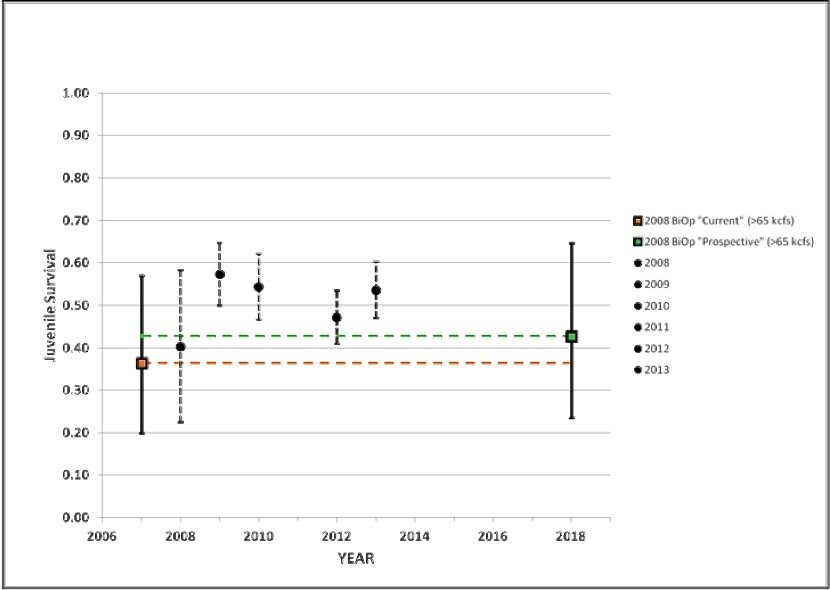forum
library
tutorial
contact

Questions Over NOAA's
Latest Juvenile Survival Analysis
by Bill Rudolph
NW Fishletter, October 23, 2014
|
the film forum library tutorial contact |

|
Questions Over NOAA's
by Bill Rudolph
|
Estimated survival in 2014 of Snake River sockeye salmon (hatchery and wild combined) from the tailrace of Lower
Granite Dam to the tailrace of Bonneville Dam was 71.3 percent (95 percent Confidence Interval: 49.3, 93.3 percent).
 NOAA Fisheries' researchers say preliminary analysis of PIT-tag survival data estimates that the 49.7 percent juvenile spring Chinook through the hydro system in 2014 was nearly equal to the long-term average of 50.1 percent, and the eleventh highest of the past 16 years. But juvenile steelhead survival has turned out to be the highest, raising questions over some assumptions used in the analysis.
NOAA Fisheries' researchers say preliminary analysis of PIT-tag survival data estimates that the 49.7 percent juvenile spring Chinook through the hydro system in 2014 was nearly equal to the long-term average of 50.1 percent, and the eleventh highest of the past 16 years. But juvenile steelhead survival has turned out to be the highest, raising questions over some assumptions used in the analysis.
According to the annual memo, released Sept. 18, spring Chinook survival was lower than last year's 52.5 percent, but not significantly different, while estimated 2014 survival between Lower Granite and McNary dams was 3 percent higher for spring Chinook than the long-term average, 76.8 percent versus 73.8 percent. Between McNary and Bonneville, survival was about a half-percent above the long-term mean, 71.5 percent versus 71.0 percent.
Estimated survival for steelhead in 2014 was 31.4 percent higher than the long-term mean, 77.1 percent versus 45.7 percent, and the highest in the entire time series, which has led the researchers to examine their assumptions. In 2013, survival was estimated at 50.1 percent. The memo said estimated survival from McNary to Bonneville had a lot to do with it, with survival pegged at 102.3 percent versus the 68.3 percent average.
The memo characterized the 2014 spring migration year as one of average flows and above-average spill, similar to conditions in 2009, when juvenile steelhead survival was nearly 68 percent.
"It is possible that our survival estimates for migrant steelhead accurately reflect true survival rates that were exceptionally high in the lower Columbia in 2014. However, we do not have a good explanation for actual survival being so much higher than average in 2014; environmental conditions were average, dam operations were similar to recent years, and yearling Chinook survival was only average."
The memo said low detection probabilities at lower Columbia dams and the estuary PIT-tag trawl resulted in high standard errors and low precision of survival estimates. But the NOAA researchers said it was unlikely that sampling error could alone account for high estimates in the lower Snake reaches as well (74 percent versus 64.5 percent average).
The memo said it is likely that the very low detection probabilities "combined with violations of model assumptions to cause bias in estimated survival in the lower Columbia River reaches." The researchers said low detection probabilities can also amplify effects of assumption violations, "so that otherwise minor violations have a disproportionately large effect on survival estimates." These possible violations include differential mortality between detected and non-detected fish, and varying patterns of dam operations. The researchers were still studying the issue and would present results in their annual report.
In 2014, higher percentages of both spring Chinook and steelhead passed Lower Granite Dam before transportation started, than in 2013. But a greater proportion was transported after the program began on May 1 than last year, since transportation start dates at other lower Snake dams were not staggered compared to previous years.
NOAA estimated that 63 percent of the wild Chinook and 39 percent of hatchery Chinook had passed Lower Granite Dam before May 1. After that, 73 percent of the wild fish and 52 percent of the hatchery fish were transported.
About 49 percent of the steelhead were estimated to have passed the dam before May 1, but 63 percent were transported after barging began. Without the staggered start this year, the memo said overall transported percentages were similar to 2013.
The memo also noted that hatchery spring Chinook from the upper Columbia had an estimated survival rate of better than 93 percent from McNary to Bonneville, while upper-C hatchery steelhead had a 71.4 percent survival rate. Limited PIT-tag detection precludes survival estimates from mid-C dams.
Snake River sockeye averaged a 71.3-percent survival rate in 2014 from Lower Granite to Bonneville, while Columbia River sockeye (hatchery and wild) exhibited a 24.2-percent survival rate from Rock Island Dam to Bonneville. In 2013, the survival rate for Columbia sockeye from Rock Island to Bonneville was almost 49 percent, and nearly 80 percent in 2012.
Related Sites:
Preliminary Survival Estimates Memo from Director Richard W. Zabel to Ritchie Graves
learn more on topics covered in the film
see the video
read the script
learn the songs
discussion forum
